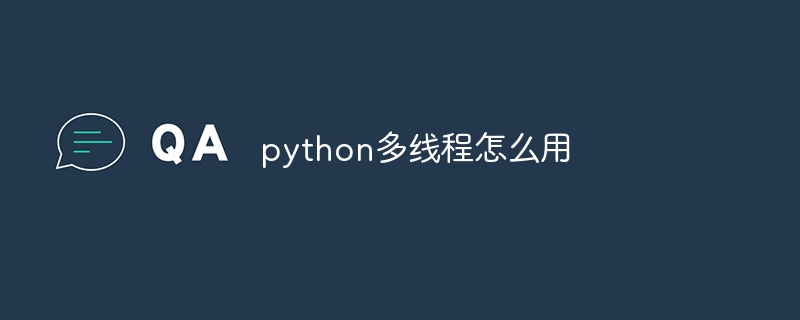
How to use python multi-threading: 1. Import the threading module; 2. Create a thread object; 3. Start the thread; 4. Wait for the thread to complete execution; 5. Multiple threads execute at the same time; 6. Thread synchronization and communication. Python multi-threading refers to using multiple threads to execute code at the same time to achieve the purpose of executing tasks concurrently. Multithreading in Python is implemented through the threading module.

The operating system for this tutorial: Windows 10 system, Python version 3.11.4, DELL G3 computer.
Python multi-threading refers to using multiple threads to execute code at the same time to achieve the purpose of executing tasks concurrently. Multithreading in Python is implemented through the threading module. Below I will introduce in detail how to use Python multi-threading.
1. Import the threading module
First you need to import the threading module, which provides multi-threading related classes and functions. The import method is as follows:
import threading
2. Create a thread object
The method of creating a thread object is as follows:
t = threading.Thread(target=func, args=args)
Among them, the target parameter specifies the function to be executed, and the args parameter specifies the function to be executed. Parameters passed to the function.
3. Start the thread
The method of starting the thread is as follows:
t.start()
This method will start a new thread and execute the specified function.
4. Wait for the thread to complete execution
You can use the join() method to wait for the thread to complete execution, as shown below:
t.join()
This method will block the current thread until the specified thread Finished.
5. Multiple threads execute simultaneously
If you want to execute multiple threads at the same time, you can create multiple thread objects and start them separately. For example:
t1 = threading.Thread(target=func1, args=args1) t2 = threading.Thread(target=func2, args=args2) t1.start() t2.start() t1.join() t2.join()
In this way, two functions func1 and func2 can be executed at the same time. Note that due to the simultaneous execution of multiple threads, there may be problems such as race conditions (race conditions), so they need to be handled with caution.
6. Thread synchronization and communication
In multi-threaded programming, thread synchronization and communication are very important concepts. You can use Lock, RLock, Condition and other classes to implement thread synchronization and communication. For example, use the Lock class to synchronize the execution of multiple threads:
lock = threading.Lock() lock.acquire() # 这里是需要同步的代码块 lock.release()
Add the acquire() and release() methods before and after the code block that needs to be synchronized to synchronize the code block. Other threads need to wait for the lock to be released when executing this code block before they can continue execution. In addition, you can also use condition variables (Condition) to implement more complex synchronization operations. For example:
cond = threading.Condition() cond.acquire() # 这里是需要同步的代码块 time.sleep(1) # 模拟等待一段时间 cond.release()
The above is the detailed content of How to use python multithreading. For more information, please follow other related articles on the PHP Chinese website!




